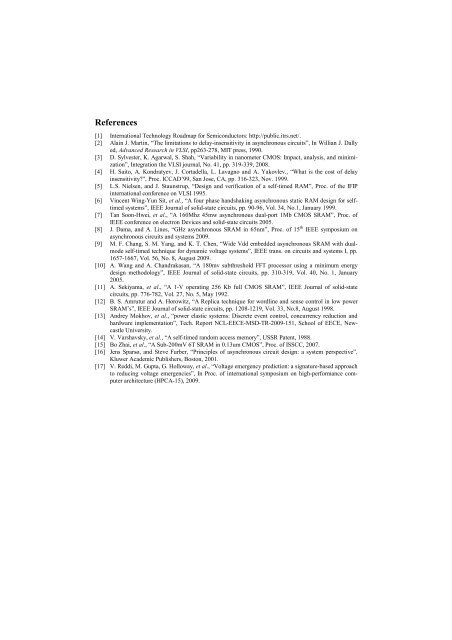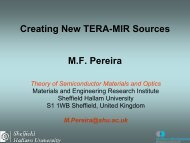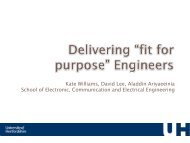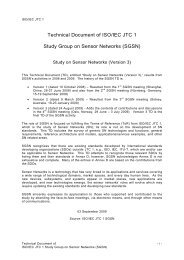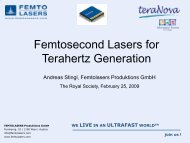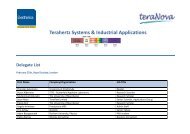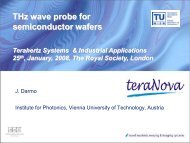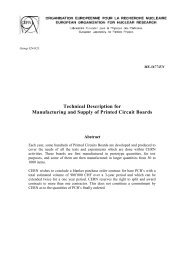Self-Timed SRAM for Energy Harvesting Systems - Electronics ...
Self-Timed SRAM for Energy Harvesting Systems - Electronics ...
Self-Timed SRAM for Energy Harvesting Systems - Electronics ...
Create successful ePaper yourself
Turn your PDF publications into a flip-book with our unique Google optimized e-Paper software.
References<br />
[1] International Technology Roadmap <strong>for</strong> Semiconductors: http://public.itrs.net/.<br />
[2] Alain J. Martin, “The limitations to delay-insensitivity in asynchronous circuits”, In Willian J. Dally<br />
ed, Advanced Research in VLSI, pp263-278, MIT press, 1990.<br />
[3] D. Sylvester, K. Agarwal, S. Shah, “Variability in nanometer CMOS: Impact, analysis, and minimization”,<br />
Integration the VLSI journal, No. 41, pp. 319-339, 2008.<br />
[4] H. Saito, A. Kondratyev, J. Cortadella, L. Lavagno and A. Yakovlev., “What is the cost of delay<br />
insensitivity”, Proc. ICCAD’99, San Jose, CA, pp. 316-323, Nov. 1999.<br />
[5] L.S. Nielsen, and J. Staunstrup, “Design and verification of a self-timed RAM”, Proc. of the IFIP<br />
international conference on VLSI 1995.<br />
[6] Vincent Wing-Yun Sit, et al., “A four phase handshaking asynchronous static RAM design <strong>for</strong> selftimed<br />
systems”, IEEE Journal of solid-state circuits, pp. 90-96, Vol. 34, No.1, January 1999.<br />
[7] Tan Soon-Hwei, et al., “A 160Mhz 45mw asynchronous dual-port 1Mb CMOS <strong>SRAM</strong>”, Proc. of<br />
IEEE conference on electron Devices and solid-state circuits 2005.<br />
[8] J. Dama, and A. Lines, “GHz asynchronous <strong>SRAM</strong> in 65nm”, Proc. of 15 th IEEE symposium on<br />
asynchronous circuits and systems 2009.<br />
[9] M. F. Chang, S. M. Yang, and K. T. Chen, “Wide Vdd embedded asynchronous <strong>SRAM</strong> with dualmode<br />
self-timed technique <strong>for</strong> dynamic voltage systems”, IEEE trans. on circuits and systems I, pp.<br />
1657-1667, Vol. 56, No. 8, August 2009.<br />
[10] A. Wang and A. Chandrakasan, “A 180mv subthreshold FFT processor using a minimum energy<br />
design methodology”, IEEE Journal of solid-state circuits, pp. 310-319, Vol. 40, No. 1, January<br />
2005.<br />
[11] A. Sekiyama, et al., “A 1-V operating 256 Kb full CMOS <strong>SRAM</strong>”, IEEE Journal of solid-state<br />
circuits, pp. 776-782, Vol. 27, No. 5, May 1992.<br />
[12] B. S. Amrutur and A. Horowitz, “A Replica technique <strong>for</strong> wordline and sense control in low power<br />
<strong>SRAM</strong>’s”, IEEE Journal of solid-state circuits, pp. 1208-1219, Vol. 33, No.8, August 1998.<br />
[13] Andrey Mokhov, et al., “power elastic systems: Discrete event control, concurrency reduction and<br />
hardware implementation”, Tech. Report NCL-EECE-MSD-TR-2009-151, School of EECE, Newcastle<br />
University.<br />
[14] V. Varshavsky, et al., “A self-timed random access memory”, USSR Patent, 1988.<br />
[15] Bo Zhai, et al., “A Sub-200mV 6T <strong>SRAM</strong> in 0.13um CMOS”, Proc. of ISSCC, 2007.<br />
[16] Jens Sparsø, and Steve Furber, “Principles of asynchronous circuit design: a system perspective”,<br />
Kluwer Academic Publishers, Boston, 2001.<br />
[17] V. Reddi, M. Gupta, G. Holloway, et al., “Voltage emergency prediction: a signature-based approach<br />
to reducing voltage emergencies”, In Proc. of international symposium on high-per<strong>for</strong>mance computer<br />
architecture (HPCA-15), 2009.


